高中英语句子成分和句子种类
- 格式:docx
- 大小:21.10 KB
- 文档页数:8
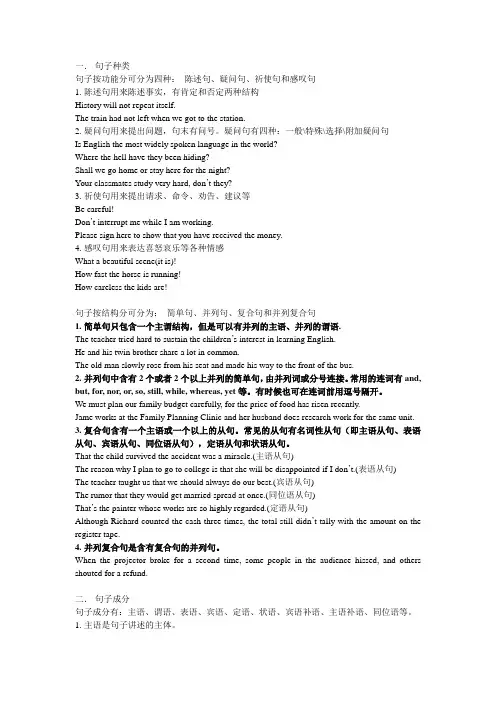
一.句子种类句子按功能分可分为四种:陈述句、疑问句、祈使句和感叹句1.陈述句用来陈述事实,有肯定和否定两种结构History will not repeat itself.The train had not left when we got to the station.2.疑问句用来提出问题,句末有问号。
疑问句有四种:一般\特殊\选择\附加疑问句Is English the most widely spoken language in the world?Where the hell have they been hiding?Shall we go home or stay here for the night?Your classmates study very hard, don’t they?3.祈使句用来提出请求、命令、劝告、建议等Be careful!Don’t interrupt me while I am working.Please sign here to show that you have received the money.4.感叹句用来表达喜怒哀乐等各种情感What a beautiful scene(it is)!How fast the horse is running!How careless the kids are!句子按结构分可分为:简单句、并列句、复合句和并列复合句1.简单句只包含一个主谓结构,但是可以有并列的主语、并列的谓语.The teacher tried hard to sustain the children’s interest in learning English.He and his twin brother share a lot in common.The old man slowly rose from his seat and made his way to the front of the bus.2.并列句中含有2个或者2个以上并列的简单句,由并列词或分号连接。

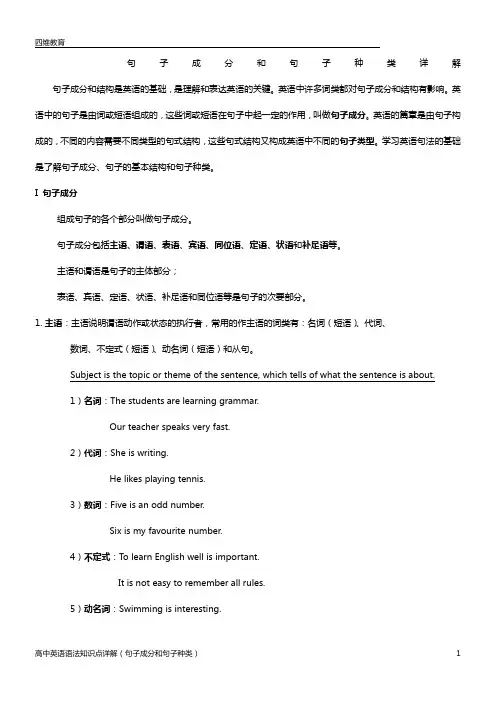
句子成分和句子种类详解句子成分和结构是英语的基础,是理解和表达英语的关键。
英语中许多词类都对句子成分和结构有影响。
英语中的句子是由词或短语组成的,这些词或短语在句子中起一定的作用,叫做句子成分。
英语的篇章是由句子构成的,不同的内容需要不同类型的句式结构,这些句式结构又构成英语中不同的句子类型。
学习英语句法的基础是了解句子成分、句子的基本结构和句子种类。
I 句子成分组成句子的各个部分叫做句子成分。
句子成分包括主语、谓语、表语、宾语、同位语、定语、状语和补足语等。
主语和谓语是句子的主体部分;表语、宾语、定语、状语、补足语和同位语等是句子的次要部分。
1.主语:主语说明谓语动作或状态的执行者,常用的作主语的词类有:名词(短语)、代词、数词、不定式(短语)、动名词(短语)和从句。
Subject is the topic or theme of the sentence, which tells of what the sentence is about.1)名词:The students are learning grammar.Our teacher speaks very fast.2)代词:She is writing.He likes playing tennis.3)数词:Five is an odd number.Six is my favourite number.4)不定式:To learn English well is important.It is not easy to remember all rules.5)动名词:Swimming is interesting.Learning grammar well is difficult.6)主语从句:What I said is true.What we can't get seems better than what we have.2.谓语:谓语用来描述主语的行为动作或所处的状态。
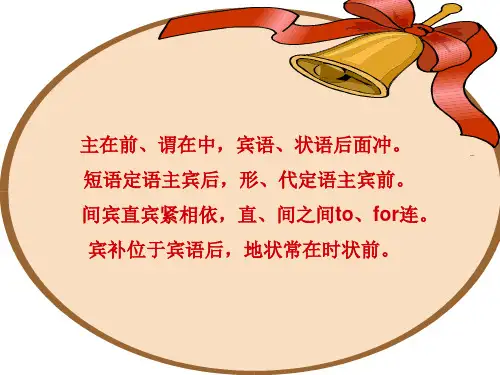
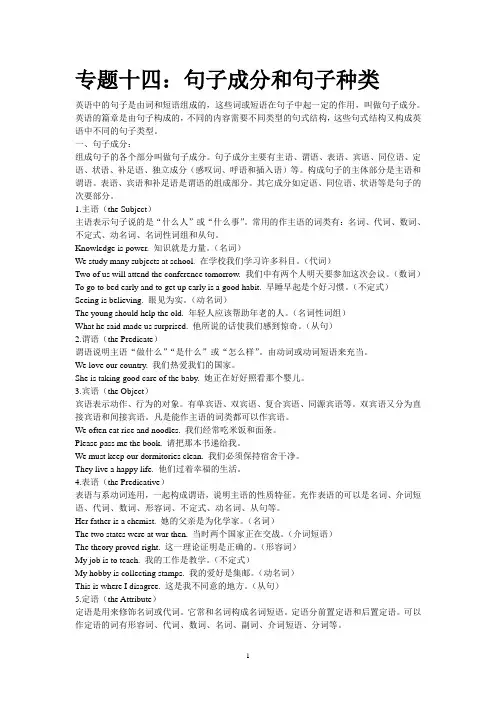
专题十四:句子成分和句子种类英语中的句子是由词和短语组成的,这些词或短语在句子中起一定的作用,叫做句子成分。
英语的篇章是由句子构成的,不同的内容需要不同类型的句式结构,这些句式结构又构成英语中不同的句子类型。
一、句子成分:组成句子的各个部分叫做句子成分。
句子成分主要有主语、谓语、表语、宾语、同位语、定语、状语、补足语、独立成分(感叹词、呼语和插入语)等。
构成句子的主体部分是主语和谓语。
表语、宾语和补足语是谓语的组成部分。
其它成分如定语、同位语、状语等是句子的次要部分。
1.主语(the Subject)主语表示句子说的是“什么人”或“什么事”。
常用的作主语的词类有:名词、代词、数词、不定式、动名词、名词性词组和从句。
Knowledge is power. 知识就是力量。
(名词)We study many subjects at school. 在学校我们学习许多科目。
(代词)Two of us will attend the conference tomorrow. 我们中有两个人明天要参加这次会议。
(数词)To go to bed early and to get up early is a good habit. 早睡早起是个好习惯。
(不定式)Seeing is believing. 眼见为实。
(动名词)The young should help the old. 年轻人应该帮助年老的人。
(名词性词组)What he said made us surprised. 他所说的话使我们感到惊奇。
(从句)2.谓语(the Predicate)谓语说明主语“做什么”“是什么”或“怎么样”。
由动词或动词短语来充当。
We love our country. 我们热爱我们的国家。
She is taking good care of the baby. 她正在好好照看那个婴儿。
3.宾语(the Object)宾语表示动作、行为的对象。
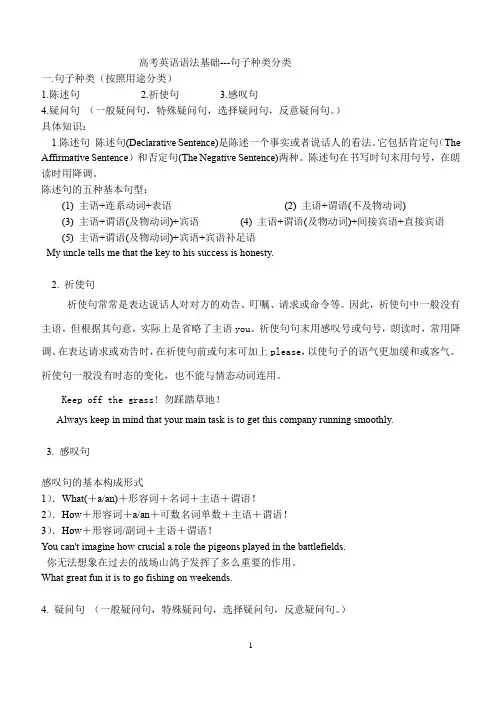
高考英语语法基础---句子种类分类一.句子种类(按照用途分类)1.陈述句2.祈使句3.感叹句4.疑问句(一般疑问句,特殊疑问句,选择疑问句,反意疑问句。
)具体知识:1.陈述句陈述句(Declarative Sentence)是陈述一个事实或者说话人的看法。
它包括肯定句(The Affirmative Sentence)和否定句(The Negative Sentence)两种。
陈述句在书写时句末用句号,在朗读时用降调。
陈述句的五种基本句型:(1) 主语+连系动词+表语(2) 主语+谓语(不及物动词)(3) 主语+谓语(及物动词)+宾语(4) 主语+谓语(及物动词)+间接宾语+直接宾语(5) 主语+谓语(及物动词)+宾语+宾语补足语My uncle tells me that the key to his success is honesty.2. 祈使句祈使句常常是表达说话人对对方的劝告、叮嘱、请求或命令等。
因此,祈使句中一般没有主语,但根据其句意,实际上是省略了主语you。
祈使句句末用感叹号或句号,朗读时,常用降调。
在表达请求或劝告时,在祈使句前或句末可加上please,以使句子的语气更加缓和或客气。
祈使句一般没有时态的变化,也不能与情态动词连用。
Keep off the grass! 勿踩踏草地!Always keep in mind that your main task is to get this company running smoothly.3. 感叹句感叹句的基本构成形式1).What(+a/an)+形容词+名词+主语+谓语!2).How+形容词+a/an+可数名词单数+主语+谓语!3).How+形容词/副词+主语+谓语!You can't imagine how crucial a role the pigeons played in the battlefields.你无法想象在过去的战场山鸽子发挥了多么重要的作用。
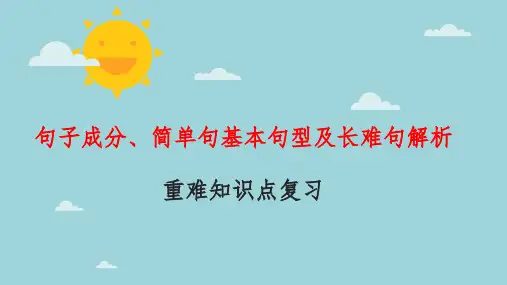
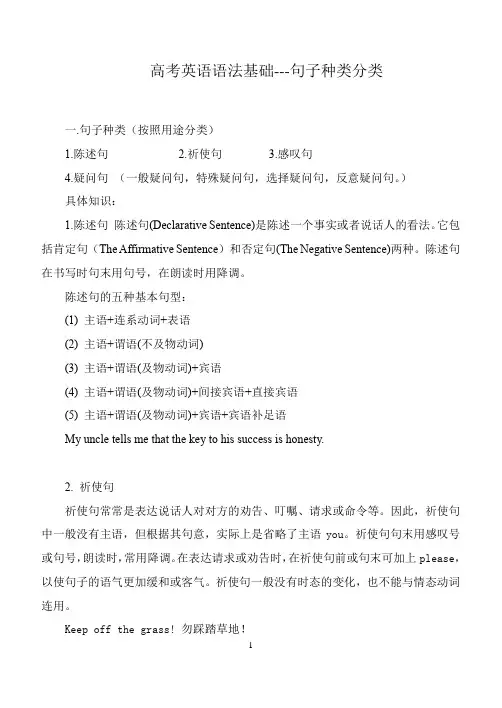
高考英语语法基础---句子种类分类一.句子种类(按照用途分类)1.陈述句2.祈使句3.感叹句4.疑问句(一般疑问句,特殊疑问句,选择疑问句,反意疑问句。
)具体知识:1.陈述句陈述句(Declarative Sentence)是陈述一个事实或者说话人的看法。
它包括肯定句(The Affirmative Sentence)和否定句(The Negative Sentence)两种。
陈述句在书写时句末用句号,在朗读时用降调。
陈述句的五种基本句型:(1) 主语+连系动词+表语(2) 主语+谓语(不及物动词)(3) 主语+谓语(及物动词)+宾语(4) 主语+谓语(及物动词)+间接宾语+直接宾语(5) 主语+谓语(及物动词)+宾语+宾语补足语My uncle tells me that the key to his success is honesty.2. 祈使句祈使句常常是表达说话人对对方的劝告、叮嘱、请求或命令等。
因此,祈使句中一般没有主语,但根据其句意,实际上是省略了主语you。
祈使句句末用感叹号或句号,朗读时,常用降调。
在表达请求或劝告时,在祈使句前或句末可加上please,以使句子的语气更加缓和或客气。
祈使句一般没有时态的变化,也不能与情态动词连用。
Keep off the grass! 勿踩踏草地!Always keep in mind that your main task is to get this company running smoothly.3. 感叹句感叹句的基本构成形式1).What(+a/an)+形容词+名词+主语+谓语!2).How+形容词+a/an+可数名词单数+主语+谓语!3).How+形容词/副词+主语+谓语!You can't imagine how crucial a role the pigeons played in the battlefields.你无法想象在过去的战场山鸽子发挥了多么重要的作用。
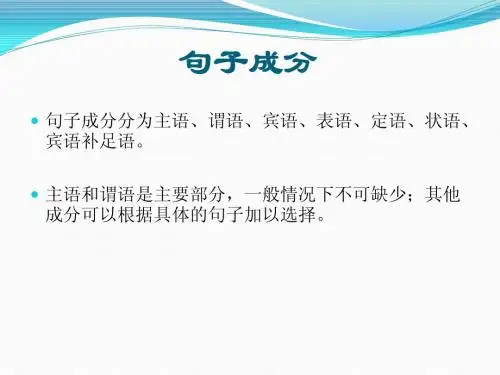
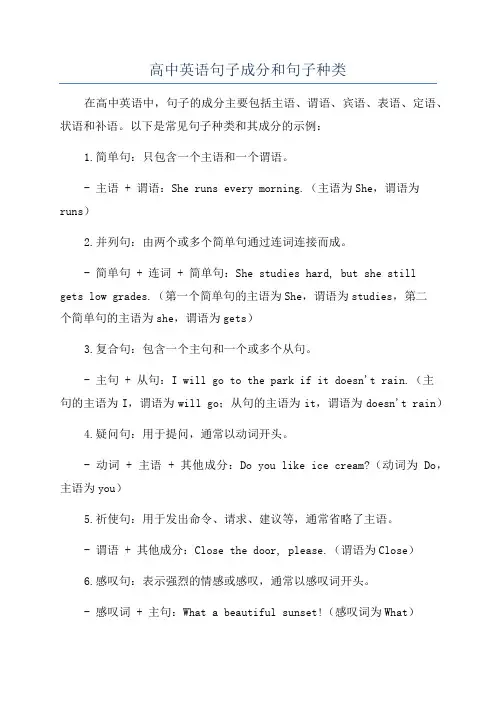
高中英语句子成分和句子种类
在高中英语中,句子的成分主要包括主语、谓语、宾语、表语、定语、状语和补语。
以下是常见句子种类和其成分的示例:
1.简单句:只包含一个主语和一个谓语。
- 主语 + 谓语:She runs every morning.(主语为She,谓语为runs)
2.并列句:由两个或多个简单句通过连词连接而成。
- 简单句 + 连词 + 简单句:She studies hard, but she still gets low grades.(第一个简单句的主语为She,谓语为studies,第二
个简单句的主语为she,谓语为gets)
3.复合句:包含一个主句和一个或多个从句。
- 主句 + 从句:I will go to the park if it doesn't rain.(主
句的主语为I,谓语为will go;从句的主语为it,谓语为doesn't rain)
4.疑问句:用于提问,通常以动词开头。
- 动词 + 主语 + 其他成分:Do you like ice cream?(动词为Do,主语为you)
5.祈使句:用于发出命令、请求、建议等,通常省略了主语。
- 谓语 + 其他成分:Close the door, please.(谓语为Close)
6.感叹句:表示强烈的情感或感叹,通常以感叹词开头。
- 感叹词 + 主句:What a beautiful sunset!(感叹词为What)
这些只是常见的句子种类和示例,实际上还有其他不同类型的句子,具体的情况需要根据语境和句子的用途来判断。
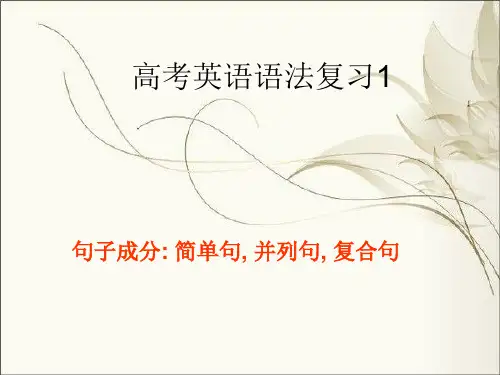
Grammar of Unit 1Different parts of a sentence概念句子是由词按照一定的语法结构组成的。
组成句子的各个部分叫做句子的成分。
句子的成分包括:主语、谓语、表语、宾语(直接和间接宾语)、宾语补足语、定语和状语。
主语和谓语是句子的主体部分(在英语中,一般句子必须有主语和谓语),表语、宾语和宾语的补足语是谓语里的组成部分。
其他成份如定语和状语是句子的次要成分。
▲句子成分分类1.主语主语是谓语讲述的对象,表示所说的“是什么”或“是谁”。
一般由名词、代词、不定代词或相当于名词的单词或短语来充当,也有从句充当的现象。
大多数主语都在句首。
如:讲述“谁” We work in a big factory.讲述“什么” The classroom is very big.数词作主语 Three are enough. 三个人就够了不定式作主语 To operate on the blind is one of the ORBIS Doctor’s job.从句作主语 What we need is food. 我们最需要的是食物.▲在“There be …”句型中,主语的位置在中间。
如:There are some bottles of milk in the box.▲在个别句型中,主语在整个句子后面,这时前面用it作形式主语。
如:It is very interesting to play the game called “treat or trick”.It took two workers about three months to build the house.2.谓语谓语时用来说明主语“做什么”、“是什么”或“怎么样”,谓语必须是动词,谓语和主语在“人称”和“数”两方面必须一致。
如:He is very generous. She looks very smart and coolWe have finished the job. He can speak German.3.表语表语说明主语“是什么”或“怎么样”,由名词、形容词、介词、副词、不定式及相当于名词的词或短语来充当,它的位置在系动词后面。
英语句子成分分类详细解析(高中)英语句子成分分类详细解析(高中)本文将详细解析英语句子成分的分类,供高中学生参考。
一、主语(Subject)主语是句子中的核心成分,通常是执行动作或者被动接受动作的实体。
主语通常回答句子中的谓语动词是“谁”或“什么”。
例如:“I love cats.”(我爱猫)中的“I”就是主语。
二、谓语(Predicate)谓语是句子中的动作或状态描述部分,通常由一个动词构成。
谓语可以是及物动词,需要接一个宾语,或者是不及物动词,不需要接宾语。
例如:“She is reading a book.”(她正在读一本书)中的“is reading”是谓语。
三、宾语(Object)宾语是谓语动词所作用的对象,它通常回答谓语动词的动作的“谁”或“什么”。
宾语可以是直接宾语或间接宾语。
直接宾语直接接在动词后,间接宾语通常通过介词与动词相关联。
例如:“He gave me a gift.”(他给了我一份礼物)中的“gift”是直接宾语,“me”是间接宾语。
表语是补充说明主语的成分,通常位于系动词之后。
表语可以是形容词、名词、副词等。
例如:“She is beautiful.”(她很漂亮)中的“beautiful”是表语。
五、状语(Adverbial)状语是修饰动词、形容词、副词或句子的成分,用来描述动作的方式、时间、地点、原因等。
状语可以放在句子的不同位置。
例如:“I often go to the park.”(我经常去公园)中的“often”就是状语。
六、定语(Adjective Modifier)定语是用来修饰名词或代词的成分,通常位于被修饰的名词或代词之前。
定语可以是形容词、名词、代词、分词等。
例如:“The red car is fast.”(红色的车跑得很快)中的“red”是定语。
七、同位语(Appositive)同位语是对某个名词或代词进行解释或补充说明的成分,通常置于被解释的名词或代词之后并用逗号隔开。
句子成分&句子结构一、句子成分句子成分主要包括主语、谓语、表语、宾语、定语、状语和补足语等;主语和谓语是句子的必需部分;宾语、表语和补足语是句子的必要部分;其他成分如状语和定语,是句子的辅助部分;有些句子还带有感叹语、插入语,它们在句法上与句子其他成分不存在关系,称为独立成分;1.主语: 主语是句中动作、行为、性质或状态的主体,是一个句子谈论的主题;主语可以由名词、代词、数词、动词不定式、动名词、从句等来充当;Some people can’t use the computer. 名词作主语He teaches us English. 代词作主语Three and five is eight. 数词作主语To read in bed is bad for your eyes. 不定式作主语Eating more vegetables is good for us. 动名词短语作主语That you forgot to tell me the time for the meeting caused me lots of trouble. 从句作主语广东Do you need more time to complete the taskYes, another ten days _____ enough.A, is B, are C, was D, were2.谓语: 谓语用来说明主语的行动、动作或所处的状态;谓语由动词或短语动词充当,一般放在主语之后;谓语可分为简单谓语和合成谓语;The boy speaks Japanese. 简单谓语Don’t get off the bus until it has stopped. 简单谓语I can play the baseball. 合成谓语Our city becomes more beautiful. 合成谓语3.宾语: 宾语表示动作、行为的对象,由名词、代词、数词、动名词、动词不定式或起名词作用的其他成分充当;I bought a book. 单宾语,名词The news surprised us. 单宾语,代词He told me the news about it. 双宾语,代词/名词A friend lent some money to me. 双宾语, 名词/代词We consider him an honest boy. 复合宾语Mr. Wang always makes his classes interesting. 复合宾语4.表语:表语用来说明主语的特征、属性、状态、身份等,与前面的连系动词一起构成系表结构作复合谓语;My pen friend is an American boy. 名词This book isn’t mine. 代词He was the first to come to school yesterday. 数词The man looks strong. 形容词My father is out. 副词His job is to clean the school. 动词不定式短语The dictionary is in the bag. 介词短语Wasting time is killing yourself. 动名词短语The trouble is that she has lost his phone number. 从句5.定语:定语是用来修饰名词或代词的句子成分,分为前置定语和后置定语两种; (1)前置定语:常用来充当前置定语的有形容词、代词、数词、名词或名词所有格,动词-ing 形式等;We had a good time in the park. adj.His father is doctor. pron.She cut the meat into two pieces. numeralThis is a stone table. n.Let’s put the child in the sleeping bag. v-ing(2)后置定语: 常用来充当后置定语的有形容词、副词、动词不定式、介词短语、分词短语和从句等;I have got something interesting to tell every one of you. Adj.The trees around were cut last week. Adv.Would do you like something to drink InfinitiveThe book on the bed is mine. Prepositional phraseThe model plane flying in the sky is made by Bill. Present participleThe woman who stands at the gate is my mother. Subordinate clause6.状语:状语常用来修饰动词、形容词、副词或整个句子;它可以表示时间、地点、程度、原因、目的、结果等;状语常由副词、介词短语、动词不定式、分词短语、从句等担当;They are walking in the park.He was looking everywhere for Jane.She was deeply moved by the story I told her.I’m sorry to keep you waiting for a long time.He spoke so fast that I couldn’t hear clearly what he said.7.补足语: 补足语是用来说明主语或宾语的性质、状态等的一种句子成分;含有宾语补足语的句子变为被动语态时,宾语补足语成了主语补足语;可以作为补足语的有名词、形容词、副词、介词短语、分词、动词不定式等;You must keep your bedroom clean.He was once again found wandering along the street.现在分词作主语补足语His parents made him stay at home. 动词不定式作宾语补足语→He was made to stay at home by his parents. 动词不定式作主语补足语8.同位语: 对句子中某一成分作进一步解释、说明,与其在语法上处于同等地位的句子成分即同位语;同位语常置于被说明的词之后;同位语由名词、代词、数词、从句等充当;This is Mr. Zhou, our headmaster.We each have a cellphone now.You may leave it to us two.We are excited about the news that we win the match.9.独立成分: 在句子中插入一个词或短语,这个词或短语并不和其他成分发生语法关系,此时这个词或短语就是一种独立成分;独立成分包括称呼语、感叹语、插入语等;Hurry up, friends, or we’ll be late. 称呼语作独立成分Aha I’ve got you right here. 感叹语作独立成分By the way, what do you usually do at weekend 插入语作独立成分二、句子结构英语句子按照结构可分为简单句、并列句和复合句;1.简单句:只有一个主语或并列主语和一个谓语或并列谓语的句子叫简单句;判断下列句子属于哪种简单句的基本句型:We walked and laughed.The children are playing.Children often sing this song.I don’t know what to do.My bike is new.He became a famous scientist.Mr. Wu teaches us English.My father bought me a new camera.We can hear someone playing the violin next door.We can keep it warm.拓展:There +be +主语+ 状语英语中有一个独特的句型叫there be 结构,该结构表示“某地/某时存在某人/某物”;There 无意义,be是谓语动词,它后面的名词是主语,两者在数上必须保持一致;句子最后为地点状语或时间状语;There is a car in front of the house.There are many books in his school bag.2.并列句: 并列句是由并列连词and, but, or, so等把两个或两个以上的简单句连在一起而构成的句子;并列连词的基本句子结构为:简单句+并列连词+ 简单句;(1)表示并列的并列连词I help her and she helps me.Both Wendy and Kate are from American.(2)表示选择的并列连词The girls can go with us, or they can stay at home.Either he or she is going to help us.(3)表示因果的并列连词The days are short, for it is now December.The boy did his homework carefully, so he never made any mistakes(4)表示转折的并列连词It is very good, yet it can be better.He is old but he is in good health.That region has plenty of natural resources while this one has none.3.复合句: 由一个主句和一个或一个以上的从句构成的句子叫做复合句;主句为句子的主体,从句不能独立,仅用作句子的一个成分,如主语、宾语、表语、同位语、定语、状语等;We shouldn’t give our children whatever they want.I’ll never forget the stories that my grandma told me.He worked for a foreign company when he was in Shanghai.一.划出下列句子中的主语①A mooncake is a delicious, round cake.②I don’t know if it will grow.③ Doing your homework in time is important.④To win the game is difficult.⑤There are some people in our classroom.⑥Five is not enough.二. 划出下列句子中的谓语①I saw a girl.②I love you.③ You should work English hard.④You had better take a bus.⑤I want to give you a book.三.划出下列句子中的宾语①I saw a cat in the tree.②We think you are right.③ My father bought me a book.④We call him LaoWang.⑤We forgot to close the window.四.划出下列句子中的定语①That is a beautiful flower.②This is my book, not your book.③ I have a lot of things to do.④I have met the boy in that room.⑤He has something important to say.五.划出下列句子中的状语①He is playing under the tree.②Ten years ago, She began to live in Dalian.③ The house is dirty because he didn’t clean it.④He buys a gift to make her happy.⑤If I am not busy tomorrow, I will play football with you.六. 划出下列句子中的表语①These desks are yellow.②It is getting cooler and cooler now.③ My work is teaching English,④It sounds good.⑤It smells nice.七. 划出句中的直接宾语和间接宾语① Please tell us a story.② My father bought a new bike for me last week.③ Mr. Li is going to teach us history next term.④ Here is a pen. Give it to Tom.⑤ Did he leave any message for me。
句子成分和句子种类详解句子成分和构造是英语的根底,是理解和表达英语的关键。
英语中许多词类都对句子成分和构造有影响。
英语中的句子是由词或短语组成的,这些词或短语在句子中起一定的作用,叫做句子成分。
英语的篇章是由句子构成的,不同的容需要不同类型的句式构造,这些句式构造又构成英语中不同的句子类型。
学习英语句法的根底是了解句子成分、句子的根本构造和句子种类。
I 句子成分组成句子的各个局部叫做句子成分。
句子成分包括主语、谓语、表语、宾语、同位语、定语、状语和补足语等。
主语和谓语是句子的主体局部;表语、宾语、定语、状语、补足语和同位语等是句子的次要局部。
1.主语:主语说明谓语动作或状态的执行者,常用的作主语的词类有:名词〔短语〕、代词、数词、不定式〔短语〕、动名词〔短语〕和从句。
Subject is the topic or theme of the sentence, which tells of what the sentence is about.1〕名词:The students are learning grammar.Our teacher speaks very fast.2〕代词:She is writing.He likes playing tennis.3〕数词:Five is an odd number.Si* is my favourite number.4〕不定式:To learn English well is important.It is not easy to remember all rules.5〕动名词:Swimming is interesting.Learning grammar well is difficult.6〕主语从句:What I said is true.What we can't get seems better than what we have.2.谓语:谓语用来描述主语的行为动作或所处的状态。
句子成分1、主语主语通常是由名词、代词、数词、名词化的形容词、不定式、动名词或从句等担任。
The apple is red.这个苹果是红色的。
(名词)Nobody can help you except yourself.只有你自己才能帮助你。
(代词)Five and four makes nine.四加五等于九。
(数词)The sick and the old need our help.病人和老人需要我们的帮助。
(名词化的形容词)To become a nurse is my wish.成为一名护士是我的心愿。
(不定式)Running is good for health.跑步有益健康。
(动名词)That he forgot to tell us the time for the meeting caused lots of trouble.他忘了告诉我开会的时间给我带来了很多麻烦。
(从句)2、谓语谓语由动词担任,有简单谓语和复合谓语之分。
(1)简单谓语简单谓语由动词或动词词组充当。
He often reads newspapers.他经常读报纸。
The plane takes off at 8 o’clock.飞机八点起飞。
(2)复合谓语复合谓语是由“情态动词或助动词+动词”构成;“连系动词+表语”也构成复合谓语。
He can speak English very well.他英语说得很好。
Our school become more beautiful.我们的学校变得更加漂亮。
3、表语表语通常由名词、代词、形容词、数词、副词、介词短语、动词不定式、动名词、分词或从句等担任。
Pollution from cars has become a major problem .汽车尾气成了一个主要问题。
(名词) Seventy-four? You don’t look it . 七十四岁?你看起来不像。
高中英语句子成分和句子种类高中英语句子成分和句子种类句子成分和结构是英语的基础,是理解和表达英语的关键。
英语中许多词类都对句子成分和结构有影响。
英语中的句子是由词或短语组成的,这些词或短语在句子中起一定的作用,叫做句子成分。
下面是小编为您带来的是高中英语句子成分和句子种类相关内容,希望对您有所帮助。
高中英语句子成分和句子种类英语的篇章是由句子构成的,不同的内容需要不同类型的句式结构,这些句式结构又构成英语中不同的句子类型。
学习英语句法的基础是了解句子成分、句子的基本结构和句子种类。
I 句子成分组成句子的各个部分叫做句子成分。
句子成分包括主语、谓语、表语、宾语、同位语、定语、状语和补足语等。
主语和谓语是句子的主体部分;表语、宾语、定语、状语、补足语和同位语等是句子的次要部分。
1. 主语:主语说明谓语动作或状态的执行者,常用的`作主语的词类有:名词(短语)、代词、数词、不定式(短语)、动名词(短语)和从句。
1)名词:The students are learning grammar.Our teacher speaks very fast.2)代词:She is writing.He likes playing tennis.3)数词:Five is an odd number.Six is my favourite number.4)不定式:To learn English well is important.It is not easy to remember all rules.5)动名词:Swimming is interesting.Learning grammar well is difficult.6)主语从句:What I said is true.What we can't get seems better than what we have.2. 谓语:谓语用来描述主语的行为动作或所处的状态。
谓语的中心词是限定动词,有人称、数和时态的变化。
1)简单谓语动词:He bought a dictionary yesterday.动词短语:He is looking for his pen.2)复合谓语系动词+表语:We are students.情态动词+不定式:I may be wrong.动词+不定式:We have to do something for them.3. 表语:表语与前面的系动词一起构成复合谓语,用来说明主语的特征、类属、状态、身份等。
充作表语的可以是单词、短语或从句。
1)名词:He is a doctor.Mr. Scott is a farmer.2)代词:It is me.That's something we have always to keep in mind.3)数词:My lucky number is nine.She was the first to learn about it.4)形容词:The classroom is big.His hair has gone white.5)副词:I am here.6)介词:We are in the classroom.7)动名词:My job is teaching them grammar.= Teaching them grammar is my job.8)分词:The film is exciting.Time is pressing. Let's hurry up.9)不定式短语:My job is to teach them grammar.All I can do is to send her a telegram.10)表语从句:He looks as if he were going to cry.The suggestion is that we should recite more words.注意:名词:身份、性质、内容。
形容词:特点、特征。
4. 宾语:宾语为动作的承受者。
1)名词:He is drinking water.I've bought an English-Chinese dictionary.2)代词:The teacher is talking to her.They didn't promise him anything.3)数词:I like six.I want the first.4)动名词:He likes watching TV.I enjoyed working with you.5)不定式:I want to buy a book.My father likes to swim in winter.6)宾语从句:He asked if he might go there.Did you write down what she said?注意:英语有单宾语、双宾语、复合宾语、同源宾语等。
1)单宾语:I can hardly hear the radio. Would you please turn it up?Please stop making noise.Do you understand what I mean?2)双宾语:双宾语指动词后面接指人和指物的两个宾语。
(指人的宾语叫间接宾语;指物的宾语叫直接宾语)其结构为:主语+及物动词(短语)+sb. + sth.Please tell me how the accident came about.(me为间接宾语,how从句为直接宾语)The teacher asked me a question.(me为间接宾语,a question为直接宾语)当直接宾语与间接宾语位置调换时,须在间接宾语前加介词to/for等。
Would you like to do me a favor?= Would you like to do a favor for me?3)复合宾语:“宾语+宾语补足语”构成了复合宾语,宾语与补足语之间具有逻辑上的主谓关系。
We all find him a nice boy.(him为宾语,a nice boy为宾语补足语)I saw a stranger waving to me.(a stranger为宾语,waving to me为宾语补足语)4)同源宾语:同源宾语指由名词担任的能重复动词部分或全部意思的直接宾语,前面常有修饰语。
laugh a good laugh大笑 smile a gentle smile 微微一笑live a happy life 过着幸福生活 die a glorious death 死得光荣dream a beautiful dream 作美梦 sing a sweet song 唱了一首甜美的歌 blow a heavy blow 沉重地一击5. 同位语:对句子中某一成分作进一步解释、说明,与前面的词在语法上处于同等地位的句子成分叫做同位语。
同位语常常置于被说明的词之后。
1)名词:Zhang Sir, our grammar teacher is humorous.This is Mr. Zhou, director of our hospital.2)代词:He himself did it.3)数词:The year, 1988 is important.We two will go shopping this afternoon.4)动名词:My task, looking after these children is important.5)不定式:My job, to teach them grammar is hard.6)同位语从句:I had no idea that you were here.The suggestion that we should recite more words is useful.6. 定语:定语是用来描述名词或代词的修饰语,它常和名词构成名词短语。
前置定语:1)名词:I want an English-Chinese dictionary.He has bought a grammar book.2)代词:This is my bag.No difficulty whatever can stop our advance.3)数词:There are two policeman in the street.Please read the first paragraph.4)冠词:This is a desk.5)形容词:I like red apples.He gave me a vivid description of the battle.6)动名词:This is a sleeping car.The swimming pool is wonderful.后置定语:7)副词:The students here are good.The buildings around are of modern construction.8)介词:The students in the classroom are good.The book on the desk is mine.9)不定式:I have an apple to eat.I have a lot of homework to do.注意:当句子的主语是不定式动作的发出者时,不定式用主动形式表被动。
10)定语从句:The students who are in the classroom are good.The boy who went to the library is our monitor.注意:是作前置定语还是后置定语取决于自身的长度。
11)分词:现在分词:This is a sleeping boy.The sleeping boy is my brother.There are some boys playing outside.过去分词:This is a broken glass.She is taking care of the newly-born child.We must solve the problems left by history.注意:动名词作定语,表示所修饰名词的性质或用途。
This is a sleeping car.= This is a car used for sleeping.分词作定语,表示所修饰名词的动作或状态。